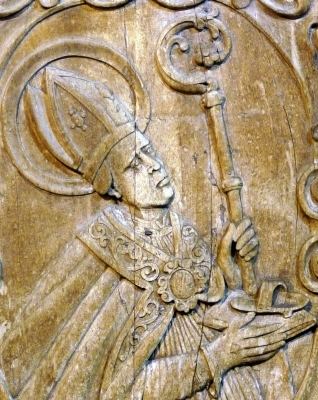Role Saint Name Vigilius Trent | Feast 26 June Major shrine Trent | |
 | ||
Attributes bishop holding a shoe; wooden clogs (Holzschuh) Similar People Pope Leo I, Pope Clement I, Pope Sixtus III, Pope Honorius III, Pope Anicetus | ||
Saint Vigilius of Trent (Italian: San Vigilio di Trento) is venerated as the patron saint and first bishop of Trent. He should not be confused with the pope of the same name. According to tradition, he was a Roman patrician and was the son of Maxentia and a man whose name is sometimes given as Theodosius.
Contents

His brothers, Claudian and Magorian, are also venerated as saints. Vigilius was educated at Athens and seems to have been a friend of Saint John Chrysostom.

He then went to Rome and then settled at Trento in 380 and was chosen to be bishop of that city. He may have been consecrated by either Ambrose of Milan or Valerian of Aquileia (Valerianus). As bishop, Vigilius attempted to convert Arians and pagans to Nicene Christianity and is said to have founded thirty parishes in his diocese. The founding of the Church of Santa Maria Maggiore, Trento is traditionally attributed to him. A letter attributed to Ambrose has the Milanese bishop encouraging Vigilius to oppose marriages between Christians and pagans (Ep. 29 in P.L., XVI, 982). Vigilius preached in Brescia and Verona, which lay outside of his diocese.
His companions during his missions were Saints Sisinnius, Martyrius and Alexander, who were sent by Ambrose to assist Vigilius. Tradition makes these three natives of Cappadocia. A work called De Martyrio SS. Sisinnii, Martyrii et Alexandri (P.L., XIII, 549) is attributed to Vigilius.
Sisinnius, Martyrius and Alexander (Sisinio, Martirio e Alessandro) were killed at Sanzeno after they attempted to convert the local population there to Christianity; Vigilius forgave their killers and had the remains of the three men sent to John Chrysostom in Constantinople, as well to Simplician, Ambrose's successor, in Milan. Milan would later give some of those relics back to Sanzeno in the 20th century, where they rest in the Basilica dei Ss. Martiri dell'Anaunia.
Vigilius is associated with the legend of St. Romedius, who is often depicted alongside or astride a bear. According to Romedius' hagiography, Romedius once wished to visit Vigilius, a friend of his youth, but Romedius' horse was torn to pieces by a wild bear. Romedius, however, had the bear bridled by his disciple David (Davide). The bear became docile and carried Romedius on its back to Trento.
Death
According to a much later tradition, Vigilius, who had been accompanied by his brothers Claudian and Magorian as well as a priest named Julian, was killed in the present-day parish of Rendena, in the Rendena Valley, where he had been preaching against the locals there, who worshipped the god Saturn. Vigilius said Mass and overturned a statue of the god into the Sarca River. As punishment, he was stoned to death near Lake Garda at the area called Punta San Vigilio.
Ironically, a statue of the pagan god Neptune stands in front of Vigilius' shrine in Trent today.
Veneration
Vigilius was buried at a church that he built at Trent, later expanded by his successor Eugippius, and dedicated to Vigilius. This became Trento Cathedral. He was immediately venerated after his death, and the acts of his life and death were sent to Rome, and Pope Innocent I, according to the Catholic Encyclopedia, "seems to have made a formal canonization, for Benedict XIV ("De canonizat. SS.", Prato, 1839, I, ch. iv, no. 12) calls Vigilius the first martyr canonized by a pope.” Vigilius’ arm was separated as a separate relic and placed into its own reliquary in 1386. He is venerated in Tyrol. A German farmers’ saying associated with a 2nd feast day of January 31 was: "Friert es zu Vigilius / im März die Eiseskälte kommen muss!" (“If it freezes on St. Vigilius’ Day / in March the ice cold will come!”). There are similar sayings associated with other “weather saints.”
